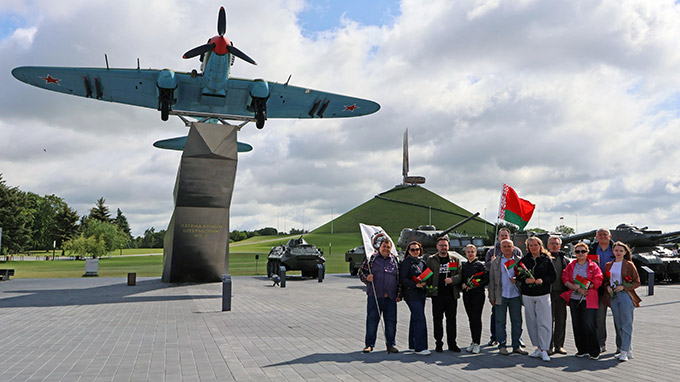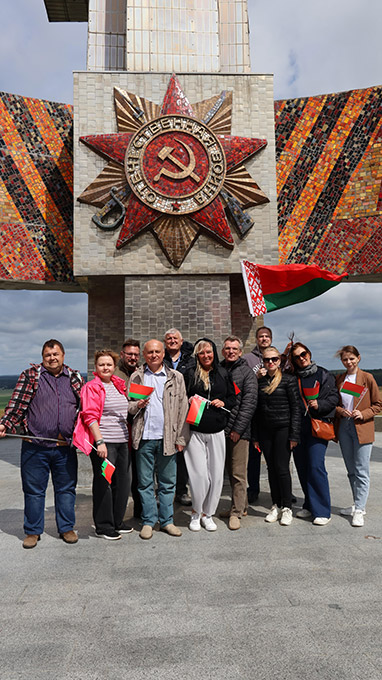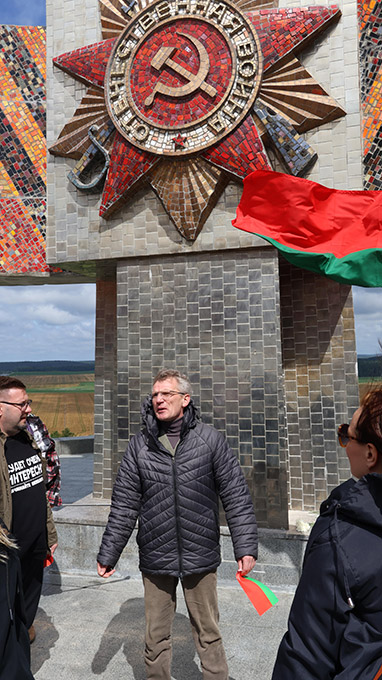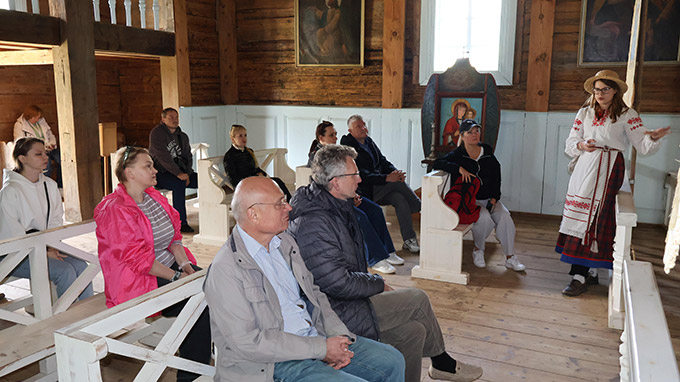Tourist trip of the employees of the Department of Archives and Records Management and heads of the republican archival institutions to the places of military glory of the Red Army during the Great Patriotic War and a visit to the Museum of Folk Architecture and Life
On June 28, 2025, a tourist trip took place to the places of military glory of the Red Army during the Great Patriotic War with a visit to the Museum of Folk Architecture and Life in the agro-town of Ozertso in the Minsk region. The trip was attended by employees of the Department of Archives and Records Management of the Ministry of Justice and heads of the republican archival institutions: the National Archives of the Republic of Belarus, the National Historical Archives of Belarus, the Belarusian State Archive-Museum of Literature and Art, the Belarusian State Archive of Scientific and Technical Documentation, the Belarusian Research Institute of Document Science and Archival Affairs, the Central Laboratory for Ensuring the Preservation of Documents of the National Archival Fund and the editorial office of the journal «Archives and Records Management».
The initiator and organizer of the trip was the National Historical Archives of Belarus. The event is dedicated to the most important national holiday – Independence Day of the Republic of Belarus, which our country will celebrate on July 3.
The first point on the tourist map was the memorial complex «Mound of Glory» – a grandiose monument to the Great Patriotic War in the Smolevichi district of the Minsk region of Belarus. It was in these places in July 1944, during the largest offensive operation «Bagration», a 150-thousand-strong group of Nazi troops was surrounded. This event was called the «Minsk pocket». The defeat of this group ended on July 11 and became another decisive step towards the liberation of Belarus. The majestic monument in memory of those fateful events was opened in 1969 and quickly earned a reputation as one of the calling cards of our republic.
 |
| 1. Participants of the excursion in front of the memorial complex «Mound of Glory» and the museum of military equipment |
 |
| 2. Participants of the excursion in front of the memorial complex «Mound of Glory» |
 |
| 3. During the excursion |
The participants of the trip laid flowers at the Mound of Glory and climbed to its top.
 |
| 4. Laying flowers at the memorial |
 |
| 5. Participants of the excursion on top of the Mound of Glory |
At the top of the Mound of Glory, as a look into the past and a tribute to the fallen, the poem «Ballad of the Mound» was recited in the author’s performance. Deputy Director of the Central Laboratory for Ensuring the Preservation of Documents and Collections of the National Academy of Sciences Mezga S.I. wrote it for the 80th anniversary of the liberation of Belarus from the Nazi invaders.
 |
| 6. Mezga S.I. reads a poem |
Then the excursionists looked with interest at the museum of military equipment of the Soviet Army, located in the open air at the foot of the Mound of Glory.
 |
| 7. Director of BGAMLI Makarenko E.A. during the inspection of the museum of military equipment |
The next stop on the tourist route was the agro-town of Ozertso in the Minsk region. This settlement is located in the middle of picturesque places, where in ancient times there could have been a settlement, later moved to the banks of the Nemiga River and eventually named Minsk. In 1944, military operations of the Minsk offensive operation took place in these places, the main result of which was the liberation of Minsk and its environs. The excursion group visited the mass grave, which contains the remains of 65 soldiers-defenders of Belarus in 1941, partisans, soldiers-liberators in 1944. The village of Ozertso was liberated by servicemen of the 26th Guards Tank Brigade, which took part in many major battles of the Great Patriotic War, including the Battle of Kursk, Operation Bagration, the East Prussian Operation. We know the names of only nine people buried in the mass grave in the agro-town of Ozertso. The excursionists honored the memory of the defenders and liberators of our land, laid flowers at the monument erected on the mass grave.
 |
| 8. Laying flowers at the monument on the mass grave |
 |
| 9. Monument to fallen soldiers |
A very educational part of the trip was a visit to the Belarusian State Museum of Folk Architecture and Life. The vast territory of the museum is divided into sectors that represent monuments of Belarusian folk wooden architecture of the late 18th – early 20th centuries, typical for various historical and ethnographic regions: Central Belarus, the Dnieper region, Poozerye. The participants of the trip examined a number of typical traditional buildings: a church, a public barn, a public school building, forges, mills and peasant huts.
 |
| 10. During the excursion in the museum of folk architecture and life |
 |
| 11. During the excursion in the wooden church |
 |
| 12. During the inspection of the peasant hut |
 |
| 13. Leaders of the NIA of Belarus Glushakov M.M. and Buloichik N.T. at the peasant hut |
The final stage of the trip was a tasting of dishes of Belarusian traditional cuisine.
Visiting memorable places in picturesque corners of our country, contact with the traditional culture of our ancestors left vivid impressions and charged with vigor and optimism.

